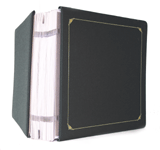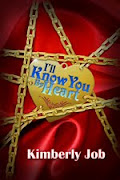Paper is readily available in the 12x12 size. It's a good size to fit pictures and other memorabilia on the pages without too much crowding. You can also buy ready-to-make pages kits in the 12x12 size.
If you want a smaller size book, there are many available such as 8x8 and 6x6 albums. These sizes are great for children to start with because the pages are small and easy to fill. The 8 1/2 x 11 size is becoming almost obsolete. The industry is steering away from it and going to the square sizes instead.
There are several questions you should contemplate before making an album purchase:
-Will I be able to find this style of album and page protectors when I need to purchase replacements or additional albums?
-Is the album trendy? Will I still like the design years from now?
-Will the album fit the number of pages I have?
-Can I afford the other components (page protectors, posts, etc.) needed to complete the album?
-Is the album durable, reliable, and easy to use?
There are three basic types of albums:
 Post-bound Album
Post-bound AlbumA post-bound album uses 2 or 3 metal posts to tightly hold pages in page protectors between a front and back cover. The posts eliminate any gutter. This means that facing layouts butt together at the center margin making them easier to look at and create designs that span two pages. These albums will accommodate both top loading and side loading page protectors. Longer posts can be purchased to allow more pages to be added.
The disadvantage of post-bound albums is that to add or remove a page, the album must be disassembled, and all or most of the pages taken out to insert or retrieve the page you want to move. Often you will need to buy page protectors from the same manufacturer as the album, because each manufacturer places the posts in a slightly different place.
A three-ring album uses clamp-style metal rings, attached to the spine on the inside cover, to hold pages in page protectors in the album. These are basically just a standard three ring binder like you used in school. These albums usually do not come with sheet protectors, which will need to be purchased separately. A major advantage to these albums is that pages can be added and removed easier than other types of albums.
A strap or hinge album uses 2-3 narrow, sturdy nylon straps that slip through "staples" to anchor pages between the front and back covers. These generally have special pages inserted that are white or black sturdy cardstock with a reinforced edge. They do not come with plastic sheet protectors, but they can be purchased separately to safeguard your finished pages.
With this type of album, your layouts are permanently attached to the page, so page planning is imperative. Because of this, these pages are not interchangeable with any other type of album.
Ultimately, your album choice will be based on personal preference. I have used all three types of albums and there are distinct advantages to each one. Personally, rather than how the albums function, I base my album choice on what the cover looks like and if it fits the personality of the pages I'll put inside.
Join the Neighborhood Newsletter . . . Subscriptions are free and joining is easy. Just by signing up and maintaining your subscription to receive the yourLDSneighborhood.com newsletter, you become eligible for our "Thank You" prizes. Our dozens of giveaways range from a trip for two to China, to iPods® (each with a $50 gift certificate for LDS music), cruises, and more.
Return to the Neighborhood.

















1 comments:
I like the 3 ring binder style with page protectors, and I put a separate piece of paper in for front and back. This way, when years later, I find a photo I missed, I can easily reshuffle the pages and add it in.
Post a Comment
I LOVE Comments!!